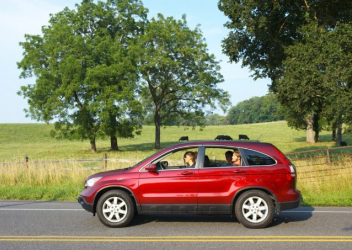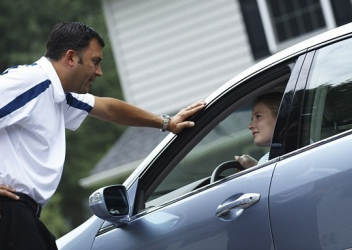Neurodevelopmental Differences and Driving
The Teen Driving Safety Research team at CIRP is currently conducting research on neurodevelopmental differences and driving to examine rates of licensure and risk of crashing for adolescents and young adults to help establish the epidemiologic foundation for future translational research. One-third of autistic individuals without intellectual disability obtain their driver's license by age 21, and two-thirds of autistic adolescents of legal driving age without intellectual disability are either currently driving or plan to drive, according to research conducted at CIRP.
This unique program of research on neurodevelopmental differences and driving is led by Allison E. Curry, PhD, MPH. Her research involves linking data from two sources: 1) electronic health records for over 114,000 CHOP patients born between 1987 and 1995 in NJ, and 2) the New Jersey Safety and Health Outcomes (NJ-SHO) Data Warehouse, a rich unique database that includes the full licensing, citation, and crash history of every NJ driver. The research is being conducted in collaboration with the Center for Autism Research at CHOP and the Center for Management of ADHD at CHOP.
Research Projects
- Caregivers' Perspectives on Use of and Need for Driving Resources for Their Autistic Adolescent
For autistic individuals, independent travel can have significant benefits for their psychosocial well-being, health, and employment opportunities. Despite strong evidence that suggests a generally safe driving experience, only one-third of adolescents without an intellectual disability are licensed by their 21st birthday. Researchers from the Center for Injury Research and Prevention and the Center for Autism Research at Children’s Hospital of Philadelphia (CHOP) conducted semi-structured interviews with 33 caregivers of autistic adolescents without an intellectual disability.
Their findings, published in the journal, Autism in Adulthood, revealed that while a few existing resources were helpful in guiding driving-related decisions, there was a limited availability of resources tailored to the unique needs of teaching or learning how to drive, particularly those supporting mental health. The identified resources, such as support groups and specialized driving instructors, were challenging to find, expensive, and perceived to have geographic and time-related barriers.
Principal Investigator: Emma Sartin, PhD, MPH
Funding: Eunice Kennedy Shriver National Institute for Child Health and Human Development
Read a blog post about the research.
- Real-World Crash Circumstances Among Newly Licensed Adolescent Drivers With and Without ADHD
Adolescents with attention-deficit/hyperactivity disorder (ADHD) have 30%–40% higher crash rates but an understanding of why they crash and crash circumstances had been lacking. To fill this gap, CIRP researchers compared prevalences of crash responsibility, driver actions, and crash types among adolescent and young adult drivers with and without ADHD who crashed within 48 months of licensure.
The study, published in the Journal of Adolescent Health, found that young drivers with ADHD were more than 9% more likely to be at fault for their crashes as compared to those without ADHD. Young drivers with ADHD were also 15% more likely to be inattentive compared to those without ADHD. With the exception that drivers with ADHD were less likely to crash while making a left/U-turn, the researchers did not find substantial differences in crash types by diagnosis.
Principal Investigator: Allison E. Curry, PhD, MPH
Funding: Eunice Kennedy Shriver National Institute for Child Health and Human Development
Read a blog post about the research.
- Transition to Adulthood for Autistic Adolescents: Topics Discussed by Healthcare Providers With Autistic Patients and Families
There is an urgent need to understand potential opportunities to identify and enhance resources available to healthcare providers supporting autistic adolescents. Toward this goal, researchers from the Center for Injury Research and Prevention and the Center for Autism Research at CHOP surveyed 74 healthcare providers about their practices discussing transition to adulthood topics with autistic patients.
Their findings, published in the Journal of Adolescent Health, describe current practices of these healthcare providers and identify opportunities to improve the transition planning process for autistic adolescents and their families.
Principal Investigator: Rachel K. Myers, PhD, MS
Funding: Eunice Kennedy Shriver National Institute for Child Health and Human Development
Read a blog post about the research.
- Behind the Wheel: Specialized Driving Instructors' Experiences and Strategies for Teaching Autistic Adolescents to Drive
Researchers from the Center for Injury Research and Prevention and the Center for Autism Research at Children's Hospital of Philadelphia conducted in-depth interviews with 17 specialized driving instructors who were trained as occupational therapists, driving rehabilitation specialists, or licensed driving instructors with experience working with young autistic drivers.
The study revealed clear observed strengths,including carefully following the rules of the road, paying close attention to their driving environment, and limited risk-taking, and a series of observed specific challenges, including being overly rule-bound and becoming easily distracted, autistic adolescents experience while learning to drive. The path to becoming licensed may be longer but is achievable with rigorous tailored instruction.
Their insights stress the importance of providing specialized, scaffolded instruction where skills are taught one at a time, allowing students to develop mastery before adding new skills. More research is needed to standardize best practices for autistic adolescent driver instruction.
Principal Investigator: Rachel K. Myers, PhD, MS
Funding: Eunice Kennedy Shriver National Institute for Child Health and Human Development
Read the abstract.
Read the press release.
Read a blog post about the research.
- Comparison of Motor Vehicle Crashes, Traffic Violations, and License Suspensions Between Autistic and Non-Autistic Adolescent and Young Adult Drivers
Researchers at Children’s Hospital of Philadelphia (CHOP) conducted the first comprehensive study to objectively examine real-world risk of crashes and traffic violations among newly licensed autistic adolescents and young adults as compared to other newly licensed young drivers.
The researchers investigated data from New Jersey residents born between 1987 and 2000 who were patients in the CHOP Healthcare Network. Their electronic health records were linked with statewide driver licensing and crash databases. The data included 486 autistic and 70,990 non-autistic licensed drivers over their first four years of driving.
The study found that compared with newly licensed non-autistic drivers, novice autistic drivers were estimated to have lower rates of moving violations and license suspensions, as well as similar to lower crash rates. Although half as likely to crash due to speeding, the autistic young drivers were three times more likely to crash when making a left or U-turn, suggesting the need for tailored training in these areas.
Principal Investigators: Allison E. Curry, PhD, MPH; Benjamin E. Yerys, PhD
Funding: Eunice Kennedy Shriver National Institute for Child Health and Human Development
Read the abstract.
Read the press release about the research.
Read a blog post about the research.
- Healthcare Providers' Discussions Regarding Transportation and Driving With Autistic and Non-Autistic Patients: A Brief Report
Researchers from the Center for Injury Research and Prevention and the Center for Autism Research at Children's Hospital of Philadelphia surveyed 78 pediatric healthcare and behavioral service providers to assess their transportation discussions with autistic patients and non-autistic patients. Compared with 1 in 2 providers who reported discussing transportation with non-autistic patients, only 1 in 5 have these conversations with their autistic patients. Few (8%) felt prepared to assess driving readiness in autistic patients, yet only a quarter referred patients to other professionals for driving-related issues.
These findings, published in the Journal of Autism and Developmental Disorders, suggest a critical need to develop resources that prepare providers and others who work with autistic youth to effectively facilitate independence and mobility as they become adults.
Principal Investigators: Emma Sartin, PhD, MPH; Benjamin E. Yerys, PhD; Rachel K Myers, PhD, MS;
Funding: Eunice Kennedy Shriver National Institute for Child Health and Human Development
Read the abstract.
Read the press release about the research.
Read a blog post about the research.
- Teaching Autistic Adolescents and Young Adults to Drive: Perspectives of Specialized Driving Instructors
This study, published in the journal Autism in Adulthood, examined specialized driving instructors' perspectives and experiences of teaching autistic adolescents and autistic young adults to drive. The researchers conducted semi-structured interviews with 17 instructors and then transcribed the interviews, coded them, and summarized common themes. The results emphasize the importance of parents in supporting their autistic adolescents in making the decision to drive and learning to drive, as well as supporting and prioritizing the development of independent life skills, such as mowing the lawn, cooking, and taking public transportation, long before getting behind the wheel.
According to the research, best practices to inform assessment and instructional approaches are urgently needed to help guide these professionals in teaching young autistic individuals, as well as others with neurodevelopmental differences to drive. However, driving instructors also recognize that specific approaches will necessarily be tailored to meet the individual and unique needs of each autistic adolescent driver. Future research will explore the knowledge and needs of healthcare providers, who are often a trusted resource for families as their autistic adolescents’ transition to adulthood, as well as the knowledge and needs of parents and autistic adolescents. With this knowledge, tools can be developed to promote driver readiness and enhance the learning-to-drive process for those with neurodevelopmental differences.
Principal Investigator: Rachel K Myers, PhD, MS
Funding: Eunice Kennedy Shriver National Institute for Child Health and Development
Read the study abstract.
Read a blog post about the research.
- Examination of Driving Outcomes Among Autistic Adolescents
This study, published in the journal Autism, found one in three autistic adolescents acquire an intermediate driver’s license, and the majority does so in their 17th year. The vast majority of autistic adolescents who receive a learner’s permit go on to receive their license within two years after becoming eligible, suggesting that families are making the decision of whether their autistic adolescents will learn to drive and pursue a license before getting behind the wheel with a learner's permit.
Researchers conducted a unique linkage of more than 52,000 electronic health records (EHR) of children born from 1987 to 1995 and NJ driver licensing data to determine current rates and patterns of licensure among autistic adolescents (without intellectual disability) and those without autism. This is the first large-scale study to provide detailed information on the number of autistic adolescents who are licensed and the rate at which they progress through the Graduated Driver Licensing (GDL) system. Nearly 90% of autistic adolescents holding learner's permits received an intermediate license within two years, at a median rate of 9.2 months later than other adolescents.
This study provides evidence to support the development of interventions to meet the unique needs of autistic adolescents who want to drive.
Principal Investigator: Allison E. Curry, PhD, MPH
Funding: CHOP Foerderer Grant of Excellence and the Eunice Kennedy Shriver National Institute for Child Health and Human Development at the National Institutes of Health
Read the study abstract.
Read a blog post about the research.
Watch a Medscape video about what clinicians should know.
- Chronic Care for ADHD: Clinical Management from Childhood Through Adolescence
To examine changes in ADHD care during the transition from childhood to adolescence, researchers conducted a retrospective, longitudinal cohort study of patients diagnosed with ADHD before age 10 to assess changes from preadolescence through adolescence in 1) frequency by which primary care providers offer ADHD care to patients; 2) range of concerns assessed during patient encounters; and 3) treatments implemented or recommended. After identifying patients from three practices included in a large primary care network, clinical care was compared among preadolescence (age 9-11), early adolescence (age 12-14), and late adolescence (age 15-18).
Published in the Journal of Developmental and Behavioral Pediatrics, the findings raise concerns about how primary care providers manage adolescents with a history of ADHD: Discussions of medication diversion and driver readiness were essentially not documented, and monitoring for risky sexual activity occurred in only about half of the adolescents. Improvements in monitoring for risky sexual behavior and driver readiness and providing patient education about medication diversion are needed.
Principal Investigators: Thomas J. Power, PhD; Allison E. Curry, PhD, MPH
Funding: Maternal and Child Health Bureau, Health Resources and Services Administration, US Department of Health and Human Services, and the Eunice Kennedy Shriver National Institute for Child Health and Development
Read the the study abstract.
Read a press release about the research.
- Longitudinal Study of Traffic Crashes, Violations, and Suspensions Among Young Drivers with ADHD
Building on a previous JAMA Pediatrics study described below that found crash risk for adolescent and young adult drivers with attention-deficit/hyperactivity disorder (ADHD) is much lower than previously reported, this study published in Pediatrics implemented a unique linkage of more than 14,900 electronic health records of children who got licensed during the study period with NJ driver licensing, traffic violations, and police-reported crash data. Within this group the researchers identified 1,769 adolescents with childhood-diagnosed ADHD and compared their crash outcomes and traffic and moving violations with those of the drivers without ADHD.
They found that young drivers diagnosed with ADHD are significantly more likely to crash, be issued traffic and moving violations, and engage in risky driving behaviors than their peers without ADHD. Although crash risk is elevated for all newly licensed drivers, the study team found it is 62% higher for those with ADHD the first month after getting licensed, and 37% higher during the first four years after licensure, regardless of their age when licensed. Drivers with ADHD also experienced higher rates of specific crash types, including driving with passengers, at-fault-, single vehicle-, injury- and alcohol-related crashes, the last risk being 109% higher than those without ADHD.
Comprehensive preventive approaches that extend beyond current recommendations are critically needed. To help inform these recommendations, the research team plans to conduct additional prospective research to better understand what happens right before adolescents with ADHD crash and the specific mechanisms by which ADHD symptoms influence crash risk.
Principal Investigator: Allison E. Curry, PhD, MPH
Funding: Eunice Kennedy Shriver National Institute for Child Health and Development
Read the study abstract.
Read a blog post about the research.
- Motor Vehicle Crash Risk Among Adolescents and Young Adults with ADHD
Published in JAMA Pediatrics, this is the first large-scale study to provide detailed information on the proportion of adolescents with ADHD who acquire a driver's license and their crash risk as compared with other newly licensed young drivers. Researchers followed a cohort of 18,522 primary care patients at CHOP who were born from 1987 through 1997 and linked their electronic health data with New Jersey driver licensing and crash data. They identified 2,479 adolescents with ADHD and 15,856 adolescents without ADHD who were age-eligible for licensure to determine the association between ADHD and driver licensing. Looking at only those licensed (1,785 with ADHD and 13,221 without ADHD), researchers analyzed factors related to crash involvement, such as gender, licensing age, and/or being prescribed medication 30 days before getting licensed.
After acquiring a driver's license, adolescents with ADHD have an estimated 36% higher motor vehicle crash risk than other newly licensed teens. This risk persists during their initial driving years, regardless of gender or age when licensed. Although elevated, this risk is far lower than the commonly reported estimate as four times higher.
Based on EHR data, only 12% of the drivers with ADHD had been prescribed an ADHD medication by a CHOP doctor in the 30 days before getting licensed.
More research is needed to help better quantify how ADHD affects crash risk to develop effective programs to manage that risk.
Principal Investigator: Allison E. Curry, PhD, MPH
Funding: Eunice Kennedy Shriver National Institute for Child Health and Development; CHOP Foerderer Grant for Excellence
Read the study abstract.
Read a blog post about neurodevelopmental differences and driving research.
Watch a Medscape video about what clinicians should know about driving with neurodevelopmental differences.
View a study recruitment flyer about this line of research.
Learn why this line of research is so important from Patty Huang, MD, CHOP researcher and developmental pediatrician in this video:
- Healthcare Providers' Discussions Regarding Transportation and Driving With Autistic and Non-Autistic Patients
Researchers from the Center for Injury Research and Prevention and the Center for Autism Research at Children's Hospital of Philadelphia surveyed 78 pediatric and behavioral service providers to assess their transportation discussions with autistic patient and non-autistic patients. The research team found that only 8% of providers feel prepared to assess whether their autistic patients are ready to drive. Half reported they had general transportation-related discussions with their non-autistic patients, while only 1 in 5 had these conversations with their autistic patients.
These findings, published in the Journal of Autism and Developmental Disorders, suggest a critical need to develop resources that prepare providers and others who work with autistic youth to effectively facilitate independence and mobility as they become adults.
Principal Investigator: Rachel K. Myers, PhD, MS
Funding: Eunice Kennedy Shriver National Institute for Child Health and Human Development
Read the abstract.
Read a press release about the research.
Read a blog post about the research.
- Behind the Wheel: Specialized Driving Instructors' Experiences and Strategies for Teaching Autistic Adolescents to Drive
Researchers from the Center for Injury Research and Prevention and the Center for Autism Research at Children's Hospital of Philadelphia conducted in-depth interviews with 17 specialized driving instructors who were trained as occupational therapists, driving rehabilitation specialists, or licensed driving instructors with experience working with young autistic drivers.
The study revealed clear observed strengths,including carefully following the rules of the road, paying close attention to their driving environment, and limited risk-taking, and a series of observed specific challenges, including being overly rule-bound and becoming easily distracted, autistic adolescents experience while learning to drive. The path to becoming licensed may be longer but is achievable with rigorous tailored instruction.
Their insights stress the importance of providing specialized, scaffolded instruction where skills are taught one at a time, allowing students to develop mastery before adding new skills. More research is needed to standardize best practices for autistic adolescent driver instruction.
Principal Investigator: Rachel K. Myers, PhD, MS
Funding: Eunice Kennedy Shriver National Institute for Child Health and Human Development
Read the abstract.
Read the press release.
Read a blog post about the research.
- Behind the Wheel: Specialized Driving Instructors' Experiences and Strategies for Teaching Autistic Adolescents to Drive
Researchers from the Center for Injury Research and Prevention and the Center for Autism Research at Children's Hospital of Philadelphia conducted in-depth interviews with 17 specialized driving instructors who were trained as occupational therapists, driving rehabilitation specialists, or licensed driving instructors with experience working with young autistic drivers.
The study revealed clear observed strengths,including carefully following the rules of the road, paying close attention to their driving environment, and limited risk-taking, and a series of observed specific challenges, including being overly rule-bound and becoming easily distracted, autistic adolescents experience while learning to drive. The path to becoming licensed may be longer but is achievable with rigorous tailored instruction.
Their insights stress the importance of providing specialized, scaffolded instruction where skills are taught one at a time, allowing students to develop mastery before adding new skills. More research is needed to standardize best practices for autistic adolescent driver instruction.
Principal Investigator: Rachel K. Myers, PhD, MS
Funding: Eunice Kennedy Shriver National Institute for Child Health and Human Development
Read the abstract.
Read the press release.
Read a blog post about the research.























